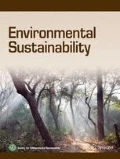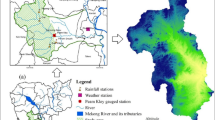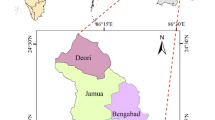Abstract
The present study investigates impact of land use land cover (LULC) change and water harvesting interventions in Kanva watershed, a rural catchment in Kaveri basin, located in semi arid region of southern India. Remote sensing data and Soil and Water assessment Tool hydrological model was used to assess changes in total water yield, groundwater recharge, percolation and evapotranspiration. Post classification change detection technique was used for LULC change analysis in 1992, 2001, 2008 and 2014. Modelling was also performed to assess potential impact of LULC using predicted land use scenario of 2022. A comparison between 1995–2003 (pre-watershed management) and 2004–2016 (post-watershed management) simulations indicated an increase of 1.01%, 4.65% and 1.74% in average runoff coefficient, groundwater recharge coefficient and percolation coefficient respectively, and decrease in evaporation coefficient by 0.51%. The results showed that LULC changes and water harvesting accounted for a difference in hydrological components between these two periods. Scenario analyses were performed for different adoption rates of rain water harvesting (RWH) interventions in sub-watersheds of Kanva watershed and its impact on hydrological parameters, especially on total water yield was identified. The analysis indicated that average runoff coefficient was 9.16% during pre-watershed period and 9.25% during post-watershed period. Further up-scaling of RWH would reduce the flow and runoff coefficient may decrease to 6.07% if RWH is adopted in whole of Kanva watershed. The results suggested that if extensive RWH is carried out in the Kanva watershed, it would result in unsustainable water management due to reduced flow downstream. The study found that the sustainability of watersheds in arid and semi-arid regions is very important given the uncertainties in future hydrologic regimes due to changes in land cover and changes in extreme rainfall patterns thus requiring suitable management interventions.





Similar content being viewed by others
References
Ajami NK, Hornberger GM, Sunding DL (2008) Sustainable water resource management under hydrological uncertainty. Water Resour Res 44:W11406
Ali M, Khan SJ, Aslam I, Khan Z (2011) Simulation of the impacts of land-use change on surface runoff of Lai Nullah Basin in Islamabad, Pakistan. Landsc Urban Plan 102:271–279
Arabi M, Govindaraju RS, Hantush MM (2007) A probabilistic approach for analysis of uncertainty in the evaluation of watershed management practices. J Hydrol 333:459–471
Arabi M, Frankenberger JR, Engel BA, Arnold JG (2008) Representation of agricultural conservation practices with SWAT. Hydrol Process 22:3042–3055
Arnold JG, Srinivasan R, Muttiah RS, Williams JR (1998) Large area hydrologic modeling and assessment part I: model development. JAWRA J Am Water Resour As 34:73–89
Bargués Tobella A, Reese H, Almaw A, Bayala J, Malmer A, Laudon H, Ilstedt U (2014) The effect of trees on preferential flow and soil infiltrability in an agroforestry parkland in semiarid Burkina Faso. Water Resour Res 50:3342–3354
Bilsborrow RE (1992) Population growth, internal migration, and environmental degradation in rural areas of developing countries Croissance de la population, migration interne et dégradation de l’environnement dans des aires rurales de pays en développement. Eur J Popul 8:125–148
Bronstert A, Niehoff D, Bürger G (2002) Effects of climate and land-use change on storm runoff generation: present knowledge and modelling capabilities. Hydrol Process 16:509–529
Bruijnzeel LA (1990) Hydrology of moist tropical forests and effects of conversion: a state of knowledge review. Hydrology of moist tropical forests and effects of conversion: a state of knowledge review. UNESCO-IHP, Humid Tropics Programme, Paris, p 224
Chaturvedi OP, Dagar JC, Handa AK, Kaushal R, Pandey VC (2018) Agroforestry potential for higher productivity from degraded ravine watersheds. In: Dagar J, Singh A (eds) Ravine lands: greening for livelihood and environmental security. Springer, Singapore, pp 335–360
Chu TW, Shirmohammadi A (2004) Evaluation of the SWAT model’s hydrology component in the piedmont physiographic region of Maryland. T ASAE 47:1057
Chuluun T, Ojima D (2002) Land use change and carbon cycle in arid and semi-arid lands of East and Central Asia. Sci China Ser C 45:48–54
Croke BF, Merritt WS, Jakeman AJ (2004) A dynamic model for predicting hydrologic response to land cover changes in gauged and ungauged catchments. J Hydrol 291:115–131
De Koninck R, Déry S (1997) Agricultural expansion as a tool of population redistribution in Southeast Asia. J Southe Asian Stud 28:1–26
Dile YT, Karlberg L, Daggupati P, Srinivasan R, Wiberg D, Rockström J (2016) Assessing the implications of water harvesting intensification on upstream–downstream ecosystem services: a case study in the Lake Tana basin. Sci Total Environ 542:22–35
Eastman R (2006) Idrisi taiga tutorial. Clark Labs, Clark University, Worcester
Falkenmark M (1990) Rapid population growth and water scarcity: the predicament of tomorrow’s Africa. Popul Dev Rev 16:81–94
Falkenmark M (1997) Meeting water requirements of an expanding world population. Philos Trans R Soc B 352:929–936
Fischer RA, Turner NC (1978) Plant productivity in the arid and semiarid zones. Annu Rev Plant Physio 29:277–317
Garg KK, Karlberg L, Barron J, Wani SP, Rockstrom J (2012) Assessing impacts of agricultural water interventions in the Kothapally watershed, Southern India. Hydrol Process 26:387–404
Gero AF, Pitman AJ, Narisma GT, Jacobson C, Pielke RA (2006) The impact of land cover change on storms in the Sydney Basin, Australia. Glob Planet Change 54:57–78
Gilfedder M, Rassam DW, Stenson MP, Jolly ID, Walker GR, Littleboy M (2012) Incorporating land-use changes and surface–groundwater interactions in a simple catchment water yield model. Environ Model Softw 38:62–73
Githui F, Mutua F, Bauwens W (2009) Estimating the impacts of land-cover change on runoff using the soil and water assessment tool (SWAT): case study of Nzoia catchment, Kenya/Estimation des impacts du changement d’occupation du sol sur l’écoulement à l’aide de SWAT: étude du cas du bassin de Nzoia, Kenya. Hydrol Sci J 54:899–908
GLCN (2009) Global land cover network. Global land cover 2000. http://www.glcn.org. Accessed 23 March 2017
Hutchinson CF, Varady RG, Drake S (2010) Old and new: changing paradigms in arid lands water management. Water and sustainability in arid regions. Springer, Dordrecht, pp 311–332
Hyandye CB, Worqul A, Martz LW, Muzuka AN (2018) The impact of future climate and land use/cover change on water resources in the Ndembera watershed and their mitigation and adaptation strategies. Environ Syst Res 7(1):7
Ilstedt U, Tobella AB, Bazié HR, Bayala J, Verbeeten E, Nyberg G, Sanou J, Benegas L, Murdiyarso D, Laudon H, Sheil D (2016) Intermediate tree cover can maximize groundwater recharge in the seasonally dry tropics. Sci Rep 6:21930
Kumar N, Singh SK, Singh VG, Dzwairo B (2018) Investigation of impacts of land use/land cover change on water availability of Tons River Basin, Madhya Pradesh, India. Model Earth Syst Environ 4(1):295–310
Lacombe G, Cappelaere B, Leduc C (2008) Hydrological impact of water and soil conservation works in the Merguellil catchment of central Tunisia. J Hydrol 359:210–224
Lambin EF, Turner BL, Geist HJ, Agbola SB, Angelsen A, Bruce JW, Coomes OT, Dirzo R, Fischer G, Folke C, George P (2001) The causes of land-use and land-cover change: moving beyond the myths. Glob Environ Chang 11:261–269
Li F, Cook S, Geballe GT, Burch WR Jr (2000) Rainwater harvesting agriculture: an integrated system for water management on rainfed land in China’s semiarid areas. Ambio 29:477–483
Li KY, Coe MT, Ramankutty N, De Jong R (2007) Modeling the hydrological impact of land-use change in West Africa. J Hydrol 337:258–268
Markert KN, Griffin RE, Limaye AS, McNider RT (2018) spatial modeling of land cover/land use change and its effects on hydrology within the Lower Mekong Basin. In: Vadrevu K, Ohara T, Justice C (eds) Land-atmospheric research applications in South and Southeast Asia. Springer Remote Sensing/Photogrammetry. Springer, Cham, pp 667–698
Moriasi DN, Arnold JG, Van Liew MW, Bingner RL, Harmel RD, Veith TL (2007) Model evaluation guidelines for systematic quantification of accuracy in watershed simulations. T ASABE 50:885–900
Mugabe FT, Chitata T, Kashaigili J, Chagonda I (2011) Modelling the effect of rainfall variability, land use change and increased reservoir abstraction on surface water resources in semi-arid southern Zimbabwe. Phys Chem Earth A/B/C 36:1025–1032
NASA LP DAAC (2015) ASTER Orthorectified Digital Elevation Model (DEM) Version 3. NASA EOSDIS Land Processes DAAC, USGS Earth Resources Observation and Science (EROS) Center, Sioux Falls. https://lpdaac.usgs.gov. Accessed 1 Oct 2015
Nash JE, Sutcliffe JV (1970) River flow forecasting through conceptual models part I-A discussion of principles. J Hydrol 10:282–290
Neitsch SL, Arnold JG, Kiniry JR, Williams JR, King KW (2005) Soil and water assessment tool theoretical documentation. Grassland. Soil and Water Research Laboratory, Temple
Ngigi SN, Savenije HH, Gichuki FN (2007) Land use changes and hydrological impacts related to up-scaling of rainwater harvesting and management in upper Ewaso Ng’iro river basin, Kenya. Land Use Policy 24:129–140
Nie W, Yuan Y, Kepner W, Nash MS, Jackson M, Erickson C (2011) Assessing impacts of Landuse and Landcover changes on hydrology for the upper San Pedro watershed. J Hydrol 407:105–114
Palamuleni LG, Ndomba PM, Annegarn HJ (2011) Evaluating land cover change and its impact on hydrological regime in Upper Shire river catchment, Malawi. Reg Environ Change 11:845–855
Pereira H (1992). Keynote paper. In: Parde J, Blanchard D (eds) Forests, a heritage for the future. Proceedings of the 10th World Forestry Congress, Paris, September 1991. Revue Forestiere Francaise, Paris, pp 139–150
Radhakrishna B, Vaidyanadhan R (1994) Geology of Karnataka. Geological Society of India Publication, India
Ragab R, Hamdy A (2004) Water management strategies to combat drought in the semiarid regions. In: 2nd Regional conference on Arab water 2004: water management for drought mitigation in the Mediterranean, Cairo, pp 37–101
Ragab R, Bromley J, D’Agostino DR, Lamaddalena N, Luizzi GT, Dörflinger G, Katsikides S, Montenegro S, Montenegro A (2012) Water resources management under possible future climate and land use changes: the application of the Integrated Hydrological Modelling System, IHMS. Integrated water resources management in the Mediterranean Region. Springer, Dordrecht, pp 69–90
Rogger M, Agnoletti M, Alaoui A, Bathurst JC, Bodner G, Borga M, Chaplot V, Gallart F, Glatzel G, Hall J, Holden J (2017) Land use change impacts on floods at the catchment scale: challenges and opportunities for future research. Water Resour Res 53:5209–5219
Rosegrant M, Cai X, Cline S, Nakagawa N (2002) The role of rainfed agriculture in the future of global food production. Environment and Production Technology Division Discussion Paper. International Food Policy Research Institute (IFPRI), Washington DC
Santhi C, Arnold JG, Williams JR, Dugas WA, Srinivasan R, Hauck LM (2001) Validation of the swat model on a large RWER basin with point and nonpoint sources. J Am Water Resour Assoc 37:1169–1188
Sahoo S, Dhar A, Debsarkar A, Kar A (2018) Impact of water demand on hydrological regime under climate and LULC change scenarios. Environ Earth Sci 77:341
Sahrawat KL, Wani SP, Pathak P, Rego TJ (2010) Managing natural resources of watersheds in the semi-arid tropics for improved soil and water quality: a review. Agric Water Manag 97:375–381
Savenije H (1995) Does moisture feedback affect rainfall significantly? Phys Chem Earth 20:507–513
Singh J, Knapp HV, Arnold JG, Demissie M (2005) Hydrological modeling of the Iroquois river watershed using HSPF and SWAT. J Am Water Resour Assoc 41:343–360
Strahler AH (1980) The use of prior probabilities in maximum likelihood classification of remotely sensed data. Remote Sens Environ 10:135–163
Tasdighi A, Arabi M, Harmel D (2018) A probabilistic appraisal of rainfall-runoff modeling approaches within SWAT in mixed land use watersheds. J Hydrol 564:476–489
Troy B, Sarron C, Fritsch JM, Rollin D (2007) Assessment of the impacts of land use changes on the hydrological regime of a small rural catchment in South Africa. Phys Chem Earth A/B/C 32:984–994
Ullrich A, Volk M (2009) Application of the Soil and Water Assessment Tool (SWAT) to predict the impact of alternative management practices on water quality and quantity. Agric Water Manag 96:1207–1217
UN-Water (2008) Status Report on IWRM and Water Efficiency Plans for CSD16. http://www.unwater.org/app/uploads/2017/05/UNW_Status_Report_IWRM.pdf. Accessed 13 April 2016
U.S. Geological Survey (USGS) Global Visualization Viewer server (GloVis) (2011) Landsat 4–5 TM and Landsat 7 ETM+ image data. https://glovis.usgs.gov. Accessed 13 Dec 2011
U.S. Geological Survey (USGS) Global Visualization Viewer server (GloVis) (2016) Landsat 8 OLI/TIRS image data. https://glovis.usgs.gov. Accessed 18 Nov 2017
Van Griensven A, Meixner T, Grunwald S, Bishop T, Diluzio M, Srinivasan R (2006) A global sensitivity analysis tool for the parameters of multi-variable catchment models. J Hydrol 324:10–23
Van Liew MW, Arnold JG, Garbrecht JD (2003) Hydrologic simulation on agricultural watersheds: choosing between two models. T ASAE 46:1539–1551
Vazquez-Amábile GG, Engel BA (2005) Use of SWAT to compute groundwater table depth and streamflow in the Muscatatuck River watershed. T ASAE 48:991–1003
Vema V, Sudheer KP, Chaubey I (2018) Hydrologic design of water harvesting structures through simulation-optimization framework. J Hydrol 563:460–469
Wang G, Liu J, Kubota J, Chen L (2007) Effects of land-use changes on hydrological processes in the middle basin of the Heihe River, northwest China. Hydrol Process 21:1370–1382
Wang S, Zhang Z, McVicar TR, Zhang J, Zhu J, Guo J (2012) An event-based approach to understanding the hydrological impacts of different land uses in semi-arid catchments. J Hydrol 416:50–59
Wani SP, Rockström J, Oweis TY (eds) (2009) Rainfed agriculture: unlocking the potential, vol 7. CABI, Wallingford
Wani SP, Rockstrom J, Sahrawat KL (2011) Integrated watershed management in rainfed agriculture. CRC Press, Florida
Welderufael WA, Woyessa YE, Edossa DC (2013) Impact of rainwater harvesting on water resources of the Modder river basin, central region of South Africa. Agric Water Manag 116:218–227
Wijesekara GN, Gupta A, Valeo C, Hasbani JG, Qiao Y, Delaney P, Marceau D (2012) Assessing the impact of future land-use changes on hydrological processes in the Elbow River watershed in southern Alberta, Canada. J Hydrol 412:220–232
Zadbagher E, Becek K, Berberoglu S (2018) Modeling land use/land cover change using remote sensing and geographic information systems: case study of the Seyhan Basin, Turkey. Environ Monit Assess 190(8):494
Zhang L, Nan Z, Yu W, Zhao Y, Xu Y (2018) Comparison of baseline period choices for separating climate and land use/land cover change impacts on watershed hydrology using distributed hydrological models. Sci Total Environ 622:1016–1028
Zheng MG, Cai QG, Wang ZJ (2005) Effect of prior probabilities on maximum likelihood classifier. In: Proceedings of the 25th IEEE international geoscience and remote sensing symposium, 25–29 July 2005, Seoul, pp 3753–3756
Author information
Authors and Affiliations
Corresponding author
Rights and permissions
About this article
Cite this article
Saini, M., Dutta, V., Singh, N.P. et al. Modeling and assessing land-use and hydrological regimes to future land-use scenario for sustainable watershed management in a semi-arid region of southern India. Environmental Sustainability 1, 393–409 (2018). https://doi.org/10.1007/s42398-018-00035-z
Received:
Revised:
Accepted:
Published:
Issue Date:
DOI: https://doi.org/10.1007/s42398-018-00035-z




